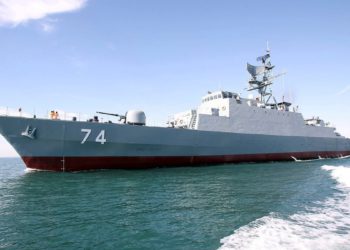Moscow, Damascus, Tel-Aviv and the S-300. Syria does not possess a modern air defence network. Said network has been degraded by nearly a decade of civil war, insurgency/counter insurgency, tight budget constraints and the occasional Israeli or American strike… There are huge holes in the Syrian radar coverage and many of the SyADF missile systems are getting old: Here is a list of SAM systems in use by the SyADF:
S-75 Dvina / S-75M Volga (1950’s)
S-125 Neva / S-125M Pechora (1960’s)
S-200 Angara/Vega/Dubna (1960’s)
2K12 Kub (1970’s)
9633 Osa (1970’s)
Buk M2 (1990’s)
Pantsir S1 (2010’s)
That’s not to say those systems are not capable, but they suffer from a lack of radar coverage and many of them are not optimised for intercepting missiles. The ones that are, are few in comparison (keep in mind Syria is a large country). Furthermore, the older a system is, the easier it is for the Israelis to jam it. As you can see, the oldest SAM systems in the Syrian arsenal are the long range ones.: S-75, S-125 and S-200. Those three are also static, they can’t be moved easily to meet new threats. Most of those are situated around the Syrian capital, Damascus. Because they are static, Israel knows their position. Syria also operates a handful of modern platforms, such as the Buck (60 units) and the Pantsir (50 units). The Buk is a good medium range platform. The Pantsir has demonstrated its ability in shooting down missiles… It has also demonstrated its inability to deal with drones… The problem for Damascus with regards to the Buk and Pantsir platforms is that it does not own enough of them. 50 platforms on paper means that about 25 to 30 are operational at any time… It is simply not enough to protect all high value sites that need protection against air raids. Buks and Pantsir seem to be used solely in the Anti-Missile/Point-Defence role in Syria. The fact they are medium and short range platforms means they do not cause any threats to Israeli aircraft which very often launch their missiles from stand-off range, from inside Israeli airspace itself, or often from Lebanese airspace or from over the Mediterranean sea.
Over time, the Israelis have gained extensive knowledge of Syrian Air Defence tactics and capabilities. They have also adapted to the Pantsir platforms that proved to be good enough to intercept a fair few Israeli missiles in and around Damascus. The Israeli Air Force adapted to this by launching several salvos of missiles at short intervals from one another, saturating the Syrian air defence. The Buks and Pantsirs can’t intercept them all. They also quickly run out of missiles and are therefore powerless to intercept the second or third wave of Israeli missiles. Also keep in mind that both the US led coalition member states have also engaged Syrian targets from stand-off distances in previous raids, so that medium and short range platforms can only hope to engage incoming missiles, rather than the planes carrying and firing them.
So… What about the S-300 complex the Syrians received in 2018? Well, for a start, there is a difference between what Moscow said it would deliver and what actually arrived in Syria! When Russia announced it would supply Damascus with the S-300 platform, the figures showed a substantial SAM network made of 3 S-300 battalions with 8 launchers each! We are talking about 24 launchers and 96 missiles ready to go! However, when the Russians delivered the goods on the 2nd of October 2018, there were 49 elements in total, including radar platforms, command vehicles and… 4 launchers. That’s basically a S-300 battery. There was no confirmation of what type of S-300 was delivered to the Syrian air Defence, but it appears to be the S-300PMU2 Favorit variant, which is an export version of the S-300 and was first unveiled in 1997.
The PMU2 comes with the 64N6E2 Big Bird surveillance radar which has a maximum detection range of 360km. That detection range drops to 260km for fighter-sized targets. Depending on which missiles it comes equipped with, it can hope to intercept targets at maximum ranges of between 195km and 250km. Israeli intelligence first reported that the Syrian S-300 battery was operational in February 2019, a full six months after having been delivered. So why hasn’t the Syrian S-300 been dropping Israeli planes ever since? Well, the battery has been deployed in Maysaf, near Hama, a fairly long way away from Israel, the Golan Heights and Damascus… It is actually situated 175km away from Damascus and 200km from the Israeli border and the annexed Golan Heights… Too far from the capital to be of any use in the defence of Damascus and Southern Syria…
By now, you must be tempted to ask “why” once again… And that’s a good question! A short and sweet answer is that one single battery of S-300 is insufficient to turn the tide in favour of the Syrians with regards to Israeli activities in the region. A battery of S-300 has 4 launchers with a total of 16 missiles ready. A well drilled Russian crew takes between 45 minutes and an hour to reload all 16 missiles. That is why the Russians never deploy a single battery of S-300 on its own. The S-300 is meant to be part of a whole ecosystem with additional batteries, radars and sensors plugged in and a couple of layers of medium and short range SAM platforms to defend it. A single battery operating as a stand-alone platform has very little chance of survival against a peer or superior opponent. The same goes for every SAM system out there. And the Syrians only have one battery and lack the necessary Buks and Pantsirs to protect it. The Israeli Air Force would not underestimate the S-300 system and if said battery was to ever be deployed around Damascus, they would make it their number one target… The Syrian S-300 battery would be targeted with heavy jamming before being overwhelmed with several waves of saturation attacks. The Syrians would gain nothing by deploying the battery further South. They know it. That’s why they do not and that’s why the S-300 remains in Maysaf.
Why hasn’t Moscow delivered more S-300 batteries to Damascus, then? Good question, once again! The first thing to keep in mind is that Moscow and Tel Aviv have friendly relations. Russia is actually the only global actor that maintains good or cordial relationships with every single country in the Middle East and North Africa! This is a difficult balancing act that the Kremlin would not want to upset. The same answer applies to online fan boys wondering why Russian SAM batteries and aircraft in Syria do not engage Israeli planes in Syria! Russia and Israel are not in a state of war. Therefore, Russia isn’t going to start engaging Israeli jets for no reason! For the same reason, the Israelis have never shown any hostility toward either of the Russian bases in Syria. Russia’s S-300 and S-400 batteries in Syria are there to protect Russian assets and personnel. That’s it. They’re not there for the benefit of the Syrians. They only intervene when one of the two Russian bases in Syria is targeted. And so far, the only ones who have targeted Russian bases in Syria are jihadis, with drones, rockets and mortar rounds.
Back to our Syrian S-300 battery! When Moscow delivered the S-300 to Damascus, it provided Syria with a glimpse of what it could receive should Assad be a bit more flexible in its approach with regards to the Syrian conflict and its relationship with Tehran. Russia, like Israel, would love for Iranian troops to back off from the Israeli border in Syria and for Iranian influence to be purged from both the Syrian presidential palace and the Syrian army. While Iranian and pro-Iranian troops were needed at the height of the war in Syria, they are now seen in Moscow as an obstacle on the road to peace. Moscow also tires of Damascus’ inflexibility with regards to the Kurdish question and with Assad’s obsession to win this war by military force.
In September 2018, the Syrian air defence shot down a Russian Il-20 Coot by accident while trying to repel an Israeli raid. It happened partly because of the fog of war hanging over Syria, a country over which countless air forces often operate without communicating with one another. This is the incident that prompted Moscow to deliver a S-300 battery to Syria. Moscow had to be seen as acting tough in its own interests and in the interests of its Syrian ally, and it did so with the delivery of a S-300 battery. In public, it appeared as a good patron/ally to Syria and it also appeared as confronting Israel. Behind the scenes, however, Tel-Aviv and Moscow negotiated a deal and a deconfliction line was established between the Israeli Air Force and the Russian base of Hmeimim. The line is used to communicate and to avoid another accident/incident where a Russian plane suddenly finds itself in the middle of an Israeli area of air operations… Russia and Israel reached an agreement mainly because neither Israel nor Russia wanted to see their relationship sour. Israel knows Russia can wield positive influence over Syria. Neither country wishes to back the other into a corner or let pride take over. Both sides were willing to negotiate and compromise.
The S-300 was deployed in Maysaf because a single battery would be useless in the defence of Damascus. And because Russia does not want to see an escalation between Israel and Syria. The S-300 sits there, full of potential for Damascus, but Russian officers/advisors retain control over the firing keys. See it as a taster, a sample of good faith given by Russia to Syria. With promises of much more to come, should Assad finally display some flexibility in his conduct of the Syrian war and his pursuit of peace. If Assad was to mellow his stance toward a new Syrian constitution, seek a peaceful resolution to the war and agree to curb Iranian influence, he would probably receive many more goodies from Russia. And there would be no objections coming from Tel-Aviv because Israel mostly engages Iranian targets in Syria, not Syrian ones. Without Iranian targets in Syria, Israel would have no reason to conduct raids on Syrian oil.










